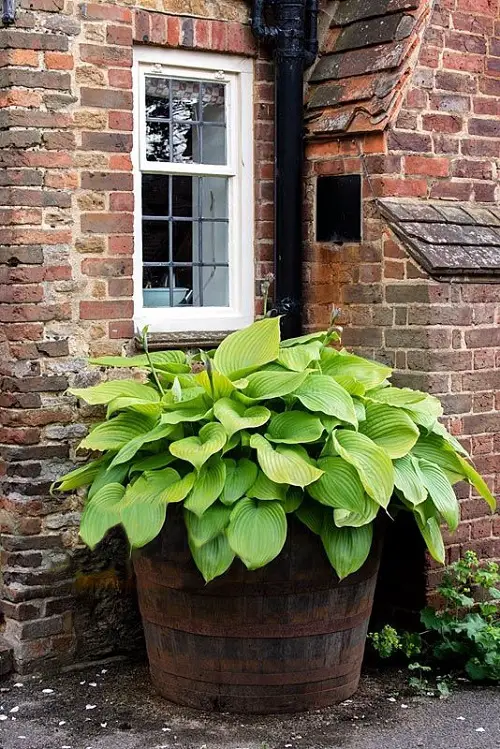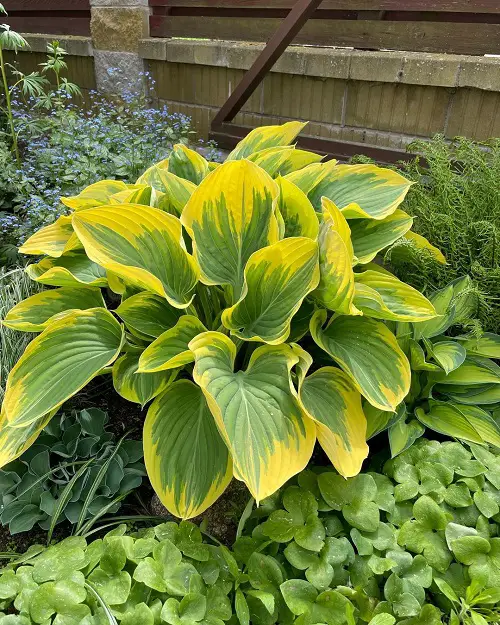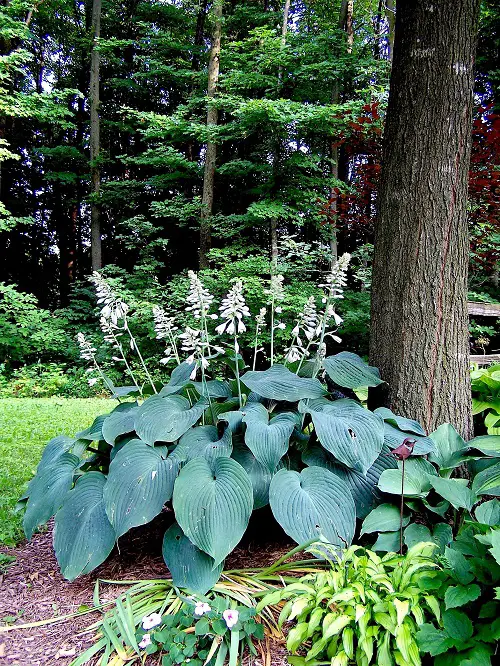Do you know the secret about How To Make Hostas Grow Bigger, Bushier, and Lusher? The answer lies in Epsom Salt!

Yes, you can Make Hostas Grow Bigger, Bushier, Lusher With Epsom Salt! The application of Epsom salt in hostas reduces stunted growth, makes their leaves greener and thicker, and boosts chlorophyll levels. It also facilitates bushier plant growth and their resistance to diseases and pests.
What Does Epsom Salt Do for Hostas?

Epsom salt is “hydrated magnesium sulfate.” It consists of 10 percent Magnesium and 13 percent Sulfur. Both are considered secondary essential nutrients after Nitrogen, Phosphorus, and Potassium.
The Magnesium in Epsom salt increases water retention, helps with nutrient intake, and, most importantly, creates chlorophyll, which is necessary for photosynthesis. On the other hand, Sulfur participates in the development of chlorophyll, increases the plant’s resistance to diseases, and helps in growth.
So, how can you use Epsom salt on hostas? Let’s see how exactly it works and how to use it.
How Epsom Salt Helps Hostas

1. Get Rid of Slugs
Slugs are the most common pests that affect hostas. To get rid of them, place a tablespoon of Epsom salt around the hostas in the shape of a ring. The salt’s sharp crystals will irritate their bodies, and they will avoid coming near your plants. Once a week is more than enough.
2. For Yellowing Hosta Leaves
Yellow hosta leaves can be a sign of Magnesium deficiency. As a solution, add a tablespoon of Epsom salt around the base of your hosta plant per 12 inches of its height once a month (or more frequently, if required) until it starts to look green again.
3. For Lush and Healthy Hosta Plants
Even if your soil is not deficient in Magnesium, some factors like acidic soil, low soil temperature, cation exchange capacity of the soil, and excess potassium or sodium reduce the uptake of Magnesium from plant roots. In any of these cases, you need to foliar feed your hosta plants with Epsom salt solution. Here’s how to use it.
- Mix two tablespoons of Epsom salt in a gallon of water. Use this spray once a month on the foliage during the rapid growth period.
- When growth slows, reduce the quantity to 1 tablespoon. The foliar application will keep your hostas lush and healthy.
4. Mix Epsom Salt with Fertilizer
You can also mix a pinch of Epsom salt with the all-purpose liquid fertilizer before feeding your hosta plants. Then, feed them as you normally do.
Tips and Warnings
Is epsom salt good for hostas? Of course! But you should remember that too much of everything is bad, so if you’re using Epsom salt for Hostas, don’t get overexcited by the results and avoid using it too much.



If we apply the circle of Epson salts once a week around the hostas to get rid of slugs, will that not make the soul too alkaline? The amount used to water them or in fertilizer seems so much lower, it worries me to try this.
I do this once every month or two, mixing a tablespoon of epsom to a large pitcher of water for each plant. My kimberly ferns are lush and green and love it, careful to only pour the water into the soil and not the leaves or fronds. Do not do more than once monthly and even if it rains.
How much water to a Tablespoon of Epsom Salt?
It takes A LOT to change soil ph so I wouldn’t worry
What if it rains do I need to reapply the salt around the base and the spray???
I am going to try this as I have been seeing lots of slugs and that concerns me. I have to wonder what it would do for Hydrangeas! Great article I plan on doing this tomorrow!
Use copper instead to keep slugs and snails out of your garden. Google for more info-
Can you use this on rosebushes?
Yes you can use epsom salts around roses. I just sprinkle the epsom salts around the base of the rosebush and let the rain wash it into the soil in the spring to give her a boost to really get a healthy start.
DEFINITELY. My rose bushes are the best they’ve ever been after applying Epson Salts once when my Forsythia blooms (which indicates when the soil has warmed) and again as they started to bud.
Can I use salts on any plants. Such as long grass ,lavender
Can I use Epson salt around my tomatoes plants?
Sure, why not.
My brother shares by Epsom when he plants his tomatoes
‘Swears”
Thanks for sharing I sure wont to try this
Can I use the Epsom salts on my elephant ear plants?
If so how much, and what is the best method of applying it to them
I thought Epsom salts on plants kills plants?
Epsom salts are not the same as common table salts. Firstly, there should be some deficiency in your plants if you’re going to use epsom salt. It’s very high in magnesium which is needed for chlorophyll and photosynthesis. Secondly, it should only be applied every few weeks in sparingly amounts. There are numerous online articles about the pros and cons of using epsom salts in your garden. Be sure to find out where, when and how much you need before using it out you could do more harm than good.
Will Epsom salts keep deer away?
Irish soap works to deter deer from eating plants.. just shave small pieces and place around the base. Reapply as needed
More junk science funded by the Epsom Salt Council.
Are you a Master Gardener of some sort?
If the leaves turn yellow when I am propagating in a vase of water, would epsom salts help? How much would I use in a small vase, please?